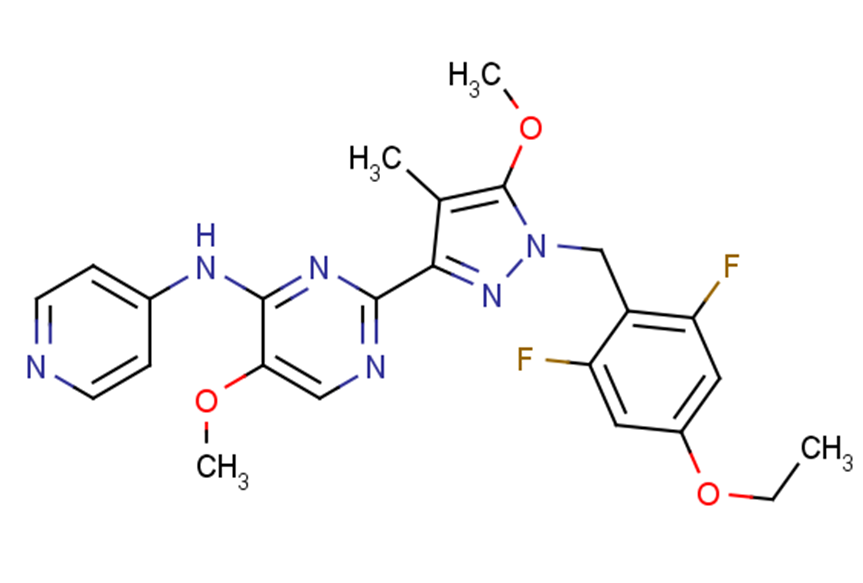
BAY524
CAS No. 1445830-39-6
BAY524( —— )
Catalog No. M22177 CAS No. 1445830-39-6
BAY-524 is an inhibitor of Bub1(IC50 = 450 nM.human Bub1 in the presence of 2 mM ATP).
Purity : >98% (HPLC)
 COA
COA
 Datasheet
Datasheet
 HNMR
HNMR
 HPLC
HPLC
 MSDS
MSDS
 Handing Instructions
Handing Instructions
| Size | Price / USD | Stock | Quantity |
| 5MG | 295 | Get Quote |


|
| 10MG | 498 | Get Quote |


|
| 25MG | 804 | Get Quote |


|
| 50MG | 1098 | Get Quote |


|
| 100MG | 1485 | Get Quote |


|
| 200MG | Get Quote | Get Quote |


|
| 500MG | Get Quote | Get Quote |


|
| 1G | Get Quote | Get Quote |


|
Biological Information
-
Product NameBAY524
-
NoteResearch use only, not for human use.
-
Brief DescriptionBAY-524 is an inhibitor of Bub1(IC50 = 450 nM.human Bub1 in the presence of 2 mM ATP).
-
DescriptionBAY-524 is an inhibitor of Bub1(IC50 = 450 nM.human Bub1 in the presence of 2 mM ATP).
-
In VitroBAY-524 inhibits the recombinant catalytic domain of human Bub1 with an IC50 of 450 nM.BAY-524 (7-10 μM or 0-30 μM; 14 h or 1 h) specifically inhibit Bub1 kinase.BAY-524 (7 μM , 12 h or 7 μM, 12 μM, 3 h) affects Sgo1 and Sgo2 localization and chromatid cohesion in cells.BAY-524 (7 μM, 10 μM) affects localization and activity of the CPC.BAY-524 (7 μM, 2 h) exerts additive effect on centromere association of CPC.BAY-524 (7 μM, 48 h) marginally affects SAC signaling.BAY-524 (7 μM, 10 μM) sensitizes cells to low doses of paclitaxel. Western Blot Analysis Cell Line:hTERT-RPE1 (RPE1) and HeLa cells Concentration:7-10 μM Incubation Time:14 hResult:Drastically reduced T120 phosphorylation.Immunofluorescence Cell Line:RPE1 and HeLa cells Concentration:0-30 μM Incubation Time:1 hResult:Reduced histone H2A-T120 phosphorylation.
-
In Vivo——
-
Synonyms——
-
PathwayOthers
-
TargetOther Targets
-
RecptorBub1
-
Research Area——
-
Indication——
Chemical Information
-
CAS Number1445830-39-6
-
Formula Weight482.48
-
Molecular FormulaC24H24F2N6O3
-
Purity>98% (HPLC)
-
SolubilityDMSO:150 mg/mL?(310.89 mM;?Need ultrasonic)
-
SMILESCCOc1cc(F)c(Cn2nc(c(C)c2OC)-c2ncc(OC)c(Nc3ccncc3)n2)c(F)c1
-
Chemical Name——
Shipping & Storage Information
-
Storage(-20℃)
-
ShippingWith Ice Pack
-
Stability≥ 2 years
Reference
1.Baron AP, et al. Probing the catalytic functions of Bub1 kinase using the small molecule inhibitors BAY-320 and BAY-524. Elife. 2016 Feb 17;5. pii: e12187.
molnova catalog



related products
-
FMRF
FMRF is a peptide consisting of 4 amino acid residues.
-
Diamide
Diamide is a reagent used as a thiol oxidizing agent.
-
Val-Ala-PAB
Val-Ala-PAB is a building block in the synthesis of Tesirine (a.k.a. SG3249), a clinical antibody-drug conjugate pyrrolobenzodiazepine dimer payload.



 Cart
Cart
 sales@molnova.com
sales@molnova.com


